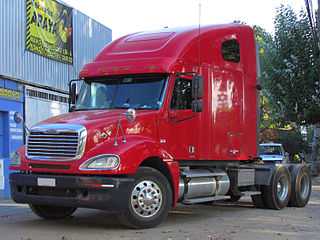
A semi-tractor-trailer truck is the combination of a tractor unit and one, or more, semi-trailers to carry freight. A semi-trailer attaches to the tractor with a type of hitch called a fifth-wheel.

A truck or lorry is a motor vehicle designed to transport cargo. Trucks vary greatly in size, power, and configuration; smaller varieties may be mechanically similar to some automobiles. Commercial trucks can be very large and powerful and may be configured to be mounted with specialized equipment, such as in the case of refuse trucks, fire trucks, concrete mixers, and suction excavators. In American English, a commercial vehicle without a trailer or other articulation is formally a "straight truck" while one designed specifically to pull a trailer is not a truck but a "tractor".

A road train, land train or long combination vehicle is a trucking vehicle of a type used in rural and remote areas of Australia and in the United States and Europe, to move road freight more efficiently. It consists of two or more trailers or semi-trailers hauled by a prime mover. Long combination vehicles are combinations of multiple trailers on tractor trucks as compared to standard 5 axle semi trailer-trucks with one trailer.

A trailer is an unpowered vehicle towed by a powered vehicle. It is commonly used for the transport of goods and materials.
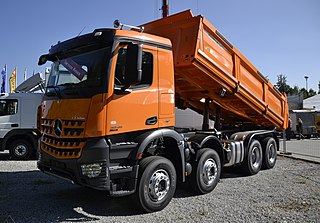
A dump truck, known also as a dumper truck or tipper truck, is used for taking dumps for construction as well as coal. A typical dump truck is equipped with an open-box bed, which is hinged at the rear and equipped with hydraulic rams to lift the front, allowing the material in the bed to be deposited ("dumped") on the ground behind the truck at the site of delivery. In the UK, Australia and India the term applies to off-road construction plant only, and the road vehicle is known as a tipper lorry, tip-truck, tip-trailer, tipper truck, or tipper.
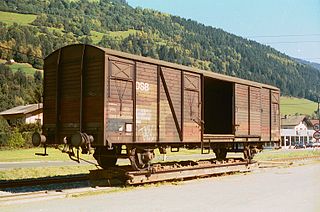
A transporter wagon, in railway terminology, is a wagon (UIC) or railroad car (US) designed to carry other railway equipment. Normally, it is used to transport equipment of a different rail gauge. In most cases, a transporter wagon is a narrower gauge wagon for transporting a wider gauge equipment, allowing freight in a wider gauge wagons to reach destinations on the narrower gauge network without the expense and time of transshipment into a narrower gauge wagons.
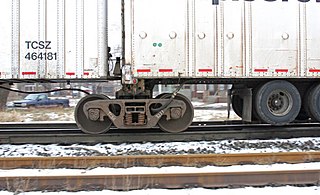
In railroad terminology, a Roadrailer or RoadRailer is a highway trailer or semi-trailer that is specially equipped for use in railroad intermodal service.
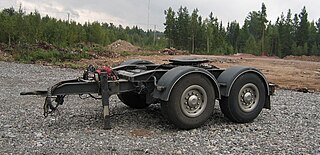
A dolly is an unpowered vehicle designed for connection to a tractor unit, truck or prime mover vehicle with strong traction power.

A tractor unit is a characteristically heavy-duty towing engine that provides motive power for hauling a towed or trailered load. These fall into two categories: heavy and medium duty military and commercial rear-wheel drive "semi-tractors" used for hauling semi-trailers, and very heavy-duty typically off-road-capable, often 6×6, military and commercial tractor units, including ballast tractors.

A semi-trailer is a trailer without a front axle. In the United States, the term is also used to refer to the combination of a truck and a semi-trailer, a tractor-trailer.

In road transport, an oversize load is a load that exceeds the standard or ordinary legal size and/or weight limits for a truck to convey on a specified portion of road, highway or other transport infrastructure, such as air freight or water freight. In Europe it may be referred to as special transport or heavy and oversized transportation. There may be load per axle limits. However, a load that exceeds the per-axle limits, but not the overall weight limits, is considered overweight. Examples of oversize/overweight loads include construction machines, pre-built homes, containers, construction elements.

The fifth-wheel coupling provides the link between a semi-trailer and the towing truck, tractor unit, leading trailer or dolly. The coupling consists of a kingpin, a 2-or-3 1⁄2-inch-diameter vertical steel pin protruding from the bottom of the front of the semi-trailer, and a horseshoe-shaped coupling device called a fifth wheel on the rear of the towing vehicle. As the connected truck turns, the downward-facing surface of the semi-trailer rotates against the upward-facing surface of the fixed fifth wheel, which does not rotate. To reduce friction, grease is applied to the surface of the fifth wheel. The configuration is sometimes called a turn-table in Australia and New Zealand, especially if it is a rotating ball-race-bearing type. The advantage of this type of coupling is towing stability.

A flatbed truck is a type of truck which can be either articulated or rigid. As the name suggests, its bodywork is just an entirely flat, level 'bed' with no sides or roof. This allows for quick and easy loading of goods, and consequently they are used to transport heavy loads that are not delicate or vulnerable to rain, and also for abnormal loads that require more space than is available on a closed body.

A heavy hauler is a very large transporter for moving oversize loads too large for road travel without an escort and special permit.

A ballast tractor is a specially weighted tractor unit of a heavy hauler combination. It is designed to utilize a drawbar to pull or push heavy or exceptionally large trailer loads. When feasible, lowboy-style semi-trailers are used to minimize a load's center of gravity. Typical drivetrains are 6×4 and 6×6.
A specialized set of jargon describe the tools, equipment, and employment sectors used in the trucking industry in the United States. Some terms may be used within other English-speaking countries, or within the freight industry in general. For example, shore power is a term borrowed from shipping terminology, in which electrical power is transferred from shore to ship, instead of the ship relying upon idling its engines. Drawing power from land lines is more efficient than engine idling and eliminates localized air pollution. Another borrowed term is "landing gear", which refers to the legs which support the front end of a semi-trailer when it is not connected to a semi-truck. Some nicknames are obvious wordplay, such as "portable parking lot", in reference to a truck that carries automobiles.

The Denby Eco-Link, dubbed the super lorry by the mainstream media, is a commercial vehicle designed and built by Denby Transport of the United Kingdom. The Eco-Link is a 60 tonne fully laden, 25.25m long, 8 axle B-Train type of semi-trailer truck, in which a tractor unit pulls two semi-trailers, using fifth wheel couplings on both trailers. As one prototype of the UK Longer Heavier Vehicle (LHV) vehicle definition, which are longer and heavier than normal Large Goods Vehicles, it is not currently permitted to be used in the UK. As of 2009, the largest ordinary lorries in the UK have 6 axles and a maximum laden weight of 44 tonnes, and can be 16.5m long as single trailer semi-trailer trucks, or 18.75m as drawbar lorries.
Transport in South Australia is provided by a mix of road, rail, sea and air transport. The capital city of Adelaide is the centre to transport in the state. With its population of 1.4 million people, it has the majority of the state's 1.7 million inhabitants. Adelaide has the state's major airport and sea port.
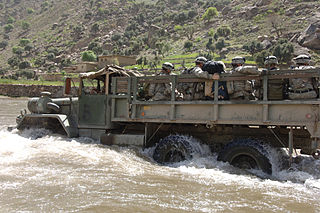
The M809 Series 5-ton 6x6 truck (G908) was a family of heavy tactical trucks built for the United States Armed Forces. The basic cargo version was designed to transport a 5-ton (4,500 kg), 14 ft (4.3 m) long load over all terrain in all weather. In on-road service the load weight was doubled. Built by AM General, they evolved into the M939 Series.

The AEC Roadtrain was a prototype road train designed by the British Overseas Mechanical Transport Committee and built by Leyland Motors and Associated Equipment Company (AEC) in the early 1930s to meet a British Army requirement for an offroad capable heavy transport vehicle to open up remote areas of the British Empire.


















